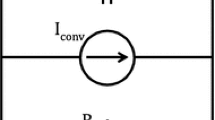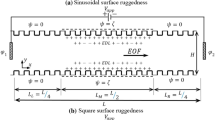Abstract
In this work, pressure drop assisted electrokinetic flow in a microchannel with asymmetric wall zeta potentials is studied. Both walls may have wall zeta potentials of the same sign or may have opposite signs. The Debye–Huckel approximation has been used to solve the equations analytically and closed-form solutions have been obtained. Friction factor increases with asymmetry in the wall zeta potentials and walls with opposite signs have larger friction factors than walls with similar signs. The analytical solution obtained for the friction factor showed that the scaled friction factor is independent of the mechanism generating the flow. Nusselt numbers also show a similar trend with wall zeta potentials. Nusselt numbers for pure electrokinetic flows are larger as compared to Nusselt numbers with pressure-assisted electrokinetic flows.
Access this chapter
Tax calculation will be finalised at checkout
Purchases are for personal use only
Similar content being viewed by others
References
Masliyah JH, Bhattacharjee S (2006) Electrokinetic and colloid transport phenomena. Wiley Interscience, New Jersey, USA
Stone HA, Stroock AD, Adjari A (2004) Engineering flows in small devices: micro fluidics towards a lab on a chip. Annu Rev Fluid Mech 36:381–411
Hadigol Mohammad, Nosrati Reza, Nourbakhsh Ahmad, Raisee Mehrdad (2011) Numerical study of electroosmotic micromixing of non-Newtonian fluids. J NonNewton Fluid Mech 166:965–971
Nayak AK (2014) Analysis of mixing for electroosmotic flow in micro/nano channels with surface heterogeneous surface potential. Int J Heat Mass Trans 75:135–144
Sadeghi A, Amini Y, Yavari H, Saidi MH (2016) Shear-rate-dependent rheology effects on mass transport and surface reactions in biomicrofluidic devices. AICHE J 61:1912–1924
Soong CY, Wang SH (2003) Theoretical analysis of electrokinetic flow and heat transfer in a microchannel under asymmetric boundary conditions. J Colloid Interf Sci 265:202–213
Mukhopadhyay Achintya, Banerjee S, Gupta C (2009) Fully developed hydrodynamic and thermal transport in combined pressure and electrokinetically driven flow in a microchannel with asymmetric boundary conditions. Int J Heat Mass Trans 52:2145–2154
Wang L, Wu J (2010) Flow behaviour in microchannel made of different materials with wall slip velocity and electro-viscous effects. Acta Mech Sin 26:73–80
Afonso AM, Alves MA, Pinho T (2012) Electro-osmotic flow of viscoelastic fluids in microchannels under asymmetric zeta potentials. J Eng Math 71:15–30
Seok W, Choi W, Joo S, Lim G (2011) Electroosmotic flows of viscoelastic fluids with asymmetric boundary conditions. J NonNewton Fluid Mech 187–188:1–7
Escandon J, Jimenez E, Hernandez C, Bautista O, Mendez F (2015) Transient electroosmotic flow of Maxwell fluids in slit microchannel with asymmetric zeta potentials. Eur J Mech B/Fluids 53:180–189
Jimenez E, Escandon J, Bautista O, Mendez F (2016) Startup electroosmotic flow of Maxwell fluids in a rectangular microchannel with high zeta potentials. J NonNewton Fluid Mech 227:17–29
Kaushik P, Chakraborty S (2017) Startup electroosmotic flow of a viscoelastic fluid characterized by Oldroyd-B model in a rectangular microchannel with symmetric and asymmetric wall zeta potentials. J NonNewton Fluid Mech 247:41–52
Bird RB, Stewart WE, Lightfoot EN (2002) Transport Phenomena, 2nd edn. Wiley, NY, USA
Chen (2012) Fully developed thermal transport in combined electroosmotic and pressure driven flow of a power law fluids in microchannels. Int J Heat Mass Trans 55:2173–2183
Author information
Authors and Affiliations
Corresponding author
Editor information
Editors and Affiliations
Rights and permissions
Copyright information
© 2019 Springer Nature Singapore Pte Ltd.
About this paper
Cite this paper
Sailaja, A., Sreenivasulu, B., Srinivas, B., Ramesh, K.V. (2019). Flow and Heat Transfer Characteristics in a Microchannel with Asymmetric Wall Zeta Potentials. In: Panda, G., Satapathy, S., Biswal, B., Bansal, R. (eds) Microelectronics, Electromagnetics and Telecommunications. Lecture Notes in Electrical Engineering, vol 521. Springer, Singapore. https://doi.org/10.1007/978-981-13-1906-8_74
Download citation
DOI: https://doi.org/10.1007/978-981-13-1906-8_74
Published:
Publisher Name: Springer, Singapore
Print ISBN: 978-981-13-1905-1
Online ISBN: 978-981-13-1906-8
eBook Packages: EngineeringEngineering (R0)




